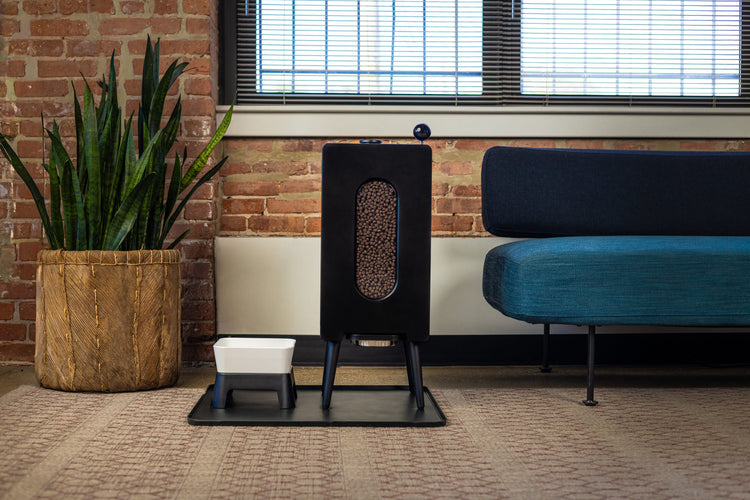How Many Calories Should a 45 lb Dog Eat? A Practical Guide for Healthier Feeding
- Houndsy
Table of Contents
- Introduction
- Understanding Calories: The Fuel for Your Dog’s Life
- Calculating Calorie Needs: The Resting and Maintenance Energy Requirements
- Factors Influencing Calorie Needs in 45 lb Dogs
- Translating Calories Into Feeding Portions
- Best Practices for Feeding Your 45 lb Dog
- Case Study: Daisy, the 45-Pound Active Labrador Retriever
- Why Quality and Convenience Matter: Houndsy’s Promise for Your Feeding Routine
- Bringing It All Together
- FAQ
Introduction
Imagine this: each time you sit down to eat, your 45-pound dog eyes you, tail wagging in hopeful anticipation. You wonder, “Am I feeding them the right amount? How many calories should a 45 lb dog eat to stay healthy and happy?” Feeding our pups well is not just about filling their bowls—it's a critical part of caring for their well-being, longevity, and happiness. Yet, determining the right calorie intake for your furry friend can feel like solving a puzzle, especially with so many variables at play.
In this post, we’ll explore the essentials behind calculating how many calories a 45-pound dog needs daily. We’ll dive into factors such as age, activity level, breed, and health status, and unpack the most effective ways to ensure your dog’s nutrition supports optimal energy and weight management. Along the way, we’ll also share tips on portion control, feeding routines, and how thoughtful design—like the Houndsy Kibble Dispenser—can make daily feeding simpler, consistent, and stylish.
Ready to rethink your dog’s meal plan and elevate the feeding ritual? Let’s get started.
Understanding Calories: The Fuel for Your Dog’s Life
Calories, also known as kilocalories (kcal), are units of energy your dog obtains from food. This energy fuels every heartbeat, wag, and playful run. The core nutrients providing calories in dog food are fats, proteins, and carbohydrates. Too few calories can lead to weight loss and malnutrition, while excess calories often lead to obesity and related health issues.
What Affects Calorie Needs?
Determining how many calories a 45 lb dog should eat daily requires more than just weight. Several key factors influence calorie requirements:
- Age: Puppies need more calories for growth. Senior dogs generally need fewer calories.
- Activity Level: Active dogs burn more energy and need more calories.
- Body Composition: Muscular dogs burn more calories than overweight dogs of the same weight.
- Spay/Neuter Status: Spayed/neutered dogs often need fewer calories.
- Health: Conditions like hypothyroidism can lower metabolic rate.
To illustrate, a lightly active 45-pound dog may need approximately 684 to 820 calories daily, but an energetic dog could require more.
Calculating Calorie Needs: The Resting and Maintenance Energy Requirements
Veterinarians use two fundamental concepts:
- Resting Energy Requirement (RER): Calories needed for vital body functions at rest.
- Maintenance Energy Requirement (MER): Calories needed daily for all activities, including exercise.
Step 1: Calculate RER
You calculate RER using this formula:
[ \text{RER} = 70 \times (\text{Body weight in kg})^{0.75} ]
Since weight in pounds converts to kilograms by dividing by 2.2:
[ 45 \text{ lb} \div 2.2 = 20.45 \text{ kg} ]
Calculating:
[ RER = 70 \times (20.45)^{0.75} \approx 70 \times 9.36 = 655 \text{ kcal/day} ]
Step 2: Adjust to MER
MER depends on the dog’s activity and life stage. Below are common multipliers:
- Neutered adult dog: RER × 1.6
- Intact adult dog: RER × 1.8
- Active, working dog: RER × 2.0–5.0
- Senior dog (less active): RER × 1.2–1.4
- Puppy (small breed): RER × 3.0
- Puppy (large breed): RER × 2.0–3.0
For a typical neutered adult 45 lb dog:
[ \text{MER} = 655 \times 1.6 = 1048 \text{ kcal/day} ]
This means a moderately active 45-pound dog will need roughly 1,000 to 1,200 calories per day.
Factors Influencing Calorie Needs in 45 lb Dogs
1. Activity Level
A surprisingly dynamic factor. For instance, a playful dog that enjoys daily runs needs more calories than a couch-loving companion. Dogs with high activity may require double the calories to sustain energy levels.
Example: A 45 lb agility dog exercising 2 hours a day may need an MER multiplier closer to 2.5, increasing caloric needs to about 1,637 calories daily.
2. Age and Growth Stage
Puppies’ energy needs skyrocket due to growth and development. An underweight or growing 45 lb dog will require more calories per pound compared to a mature adult.
Example: A 3-month-old large breed puppy weighing 45 lbs needs about 2-3 times their RER for growth, possibly around 1,500-2,000 calories.
Senior dogs tend to slow down, so their calorie intake might need to reduce to prevent unwanted weight gain.
3. Health Conditions and Spay/Neuter Status
Neutered dogs usually have lower energy requirements; a decrease of about 25% in calories can be appropriate unless activity compensates.
Medical issues such as hypothyroidism or obesity require special dietary considerations, ideally directed by a vet.
4. Weight Management
Accurate calorie control is critical for maintaining or achieving a healthy weight.
If your 45 lb dog is overweight, aim for feeding near the RER or 80% of RER to gently reduce weight, combined with increased activity.
Translating Calories Into Feeding Portions
Once you calculate how many calories your 45 lb dog should eat, you’ll want to convert this into the amount of food to give, which depends on the calorie density of their food.
Reading Food Labels
Dog foods list calories per cup or per kilogram on the package. For instance:
- Food A: 350 kcal/cup
- Food B: 480 kcal/cup
If your dog needs 1,050 kcal/day, feeding with Food A means:
[ 1,050 \div 350 = 3 \text{ cups/day} ]
With Food B:
[ 1,050 \div 480 \approx 2.2 \text{ cups/day} ]
Incorporate Treat Calories
Treats should not exceed 10% of daily calories to prevent weight gain. Opt for low-calorie treats like fish-based options rich in Omega-3 and Omega-6 for joint and brain health.
Best Practices for Feeding Your 45 lb Dog
1. Measure Portions & Use Consistent Feeding Tools
Free-feeding or guessing can lead to over- or underfeeding. We recommend using dedicated feeding tools designed with precision and convenience. The Houndsy Kibble Dispenser, for example, offers perfect portion control with a simple crank mechanism—eliminating the common mess and guesswork. It intelligently measures servings and keeps kibble fresh with a BPA-free liner, and its mid-century modern design enhances your home without sacrificing ergonomics by providing food at standing height.
2. Maintain a Feeding Schedule
Split daily calories into two or three meals for better digestion and metabolism. Puppies may require more frequent meals.
3. Monitor Weight and Adjust Accordingly
Regularly weigh your dog and evaluate their body condition score. Feel if ribs can be felt under a slight fat layer and observe their waistline when viewed from above.
Case Study: Daisy, the 45-Pound Active Labrador Retriever
Daisy is a 3-year-old neutered labrador weighing 45 lbs. She enjoys 45 minutes of active play daily and occasional weekend hikes.
- Calculated RER: 655 kcal/day
- MER multiplier for Daisy (active & neutered): 1.8
- Daily calorie need: 1,179 kcal (655 × 1.8)
Daisy's food contains 400 kcal per cup, so she receives about:
[ 1,179 \div 400 \approx 3 \text{ cups/day} ]
Using the Houndsy Kibble Dispenser ensures Daisy’s portions are consistent every time without wasting any kibble or food on the floor.
Why Quality and Convenience Matter: Houndsy’s Promise for Your Feeding Routine
At Houndsy, we understand the struggle to maintain consistent feeding while juggling busy schedules and a desire for aesthetically pleasing solutions. Founded to solve the frustrating mess and inconsistency dogging so many pet owners, our flagship Houndsy Kibble Dispenser combines:
- Convenience: Easy crank at standing height avoids bending and spills.
- Design Excellence: Clean mid-century modern aesthetic fits any decor.
- Quality & Reliability: BPA-free liner, robust mechanics, and 25–30 lbs storage capacity.
- Perfect Portion Control: Accurate servings prevent overfeeding or underfeeding.
- Safety Features: Auto-locking prevents accidental dispensing by toddlers or curious pets.
Our mission is simple yet profound: simplify the feeding experience so your dog gets precisely what they need, every time.
Bringing It All Together
Knowing how many calories should a 45 lb dog eat is about more than numbers—it's about tuning into your dog’s unique needs and lifestyle. While the general guideline centers around roughly 1,000 to 1,200 calories per day for a moderately active neutered 45 lb dog, individual factors will always shift this range.
With careful calculation using RER and MER, thoughtful conversion of calories into food portions, and attentive monitoring combined with tools like the Houndsy Kibble Dispenser, feeding your dog becomes a seamless part of your daily routine. You gain peace of mind knowing your dog’s nutritional needs are met without hassles or mess.
Ask yourself:
- How consistent is my dog’s current feeding routine?
- Am I confident the portions I give match their energy needs?
- Could a better feeding setup improve my daily experience and my dog’s health?
If you’re ready to combine science-backed feeding with effortless daily use and beautiful design, explore the Houndsy Kibble Dispenser today. Your dog—and your home—will thank you.
FAQ
Q1: Can a 45 lb dog eat the same amount of calories every day?
A: Not necessarily. Calorie needs vary based on activity, age, health, and even weather. Adjust feeding amounts seasonally or after exercise changes.
Q2: How often should I feed a 45 lb dog?
A: Twice daily is standard for adult dogs; puppies may need three or more meals.
Q3: What if my dog gains weight despite controlling calories?
A: Review both calorie intake and physical activity. Consult your vet to rule out medical conditions affecting metabolism.
Q4: How can I avoid overfeeding with treats?
A: Keep treats under 10% of daily calories. Use low-calorie, nutritious treats like fish-based options.
Q5: Is it better to free-feed or schedule meals?
A: Scheduled meals help regulate calorie intake, prevent obesity, and establish a routine.
Q6: How do I transition my dog’s diet if switching foods?
A: Gradually mix new food with old over 7-10 days to avoid digestive upset.
Q7: Can the Houndsy Kibble Dispenser help with portion control?
A: Absolutely. Its precise crank mechanism measures consistent servings every time.
For more details on making dog feeding easier, more accurate, and elegant, discover the Houndsy Kibble Dispenser here. Your dog’s ideal meal starts with a perfect portion—and a perfect feed.












